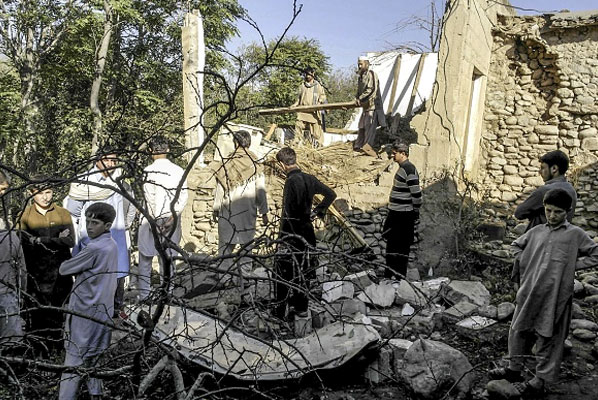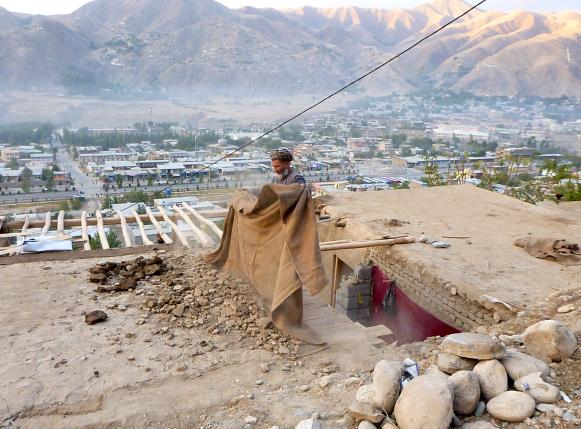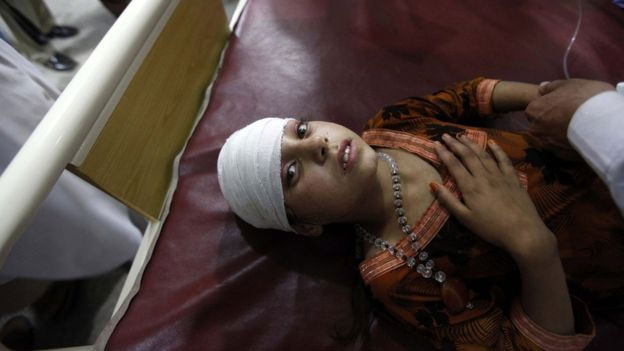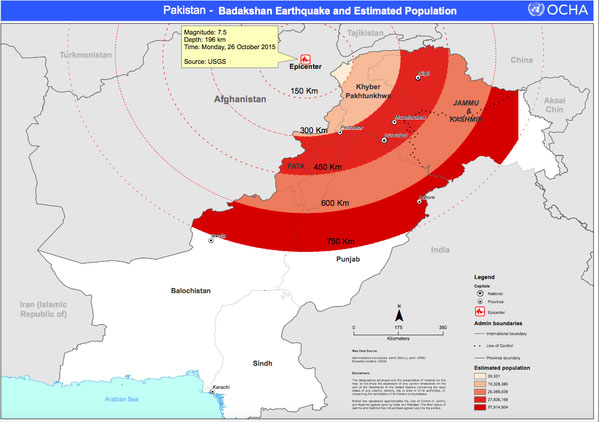Earthquake death toll rises to 257 in Pakistan

According to NDMA, deaths of 257 people has been confirmed so far.
ISLAMABAD (Web Desk / AFP) - Rescuers were Tuesday picking their way through rugged terrain in the search for survivors after a massive quake hit Pakistan and Afghanistan, killing hundreds of people.
The toll was expected to rise as search teams reach remote areas that were cut off by the powerful 7.5 magnitude quake, which triggered landslides and stampedes as it toppled buildings and severed communication lines.
The bulk of the casualties were reported from Pakistan, where 257 people were killed and more than 1,600 injured, the National Disaster Management Authority reported.
According to report, 185 people have been killed in Khyber Pakhtunkhwa, 30 in FATA, 9 in Gilgit Baltistan, 5 in Punjab and 2 in Azad Kashmir.
According to PDMA Khyber-Pakhtunkhwa, 49 people were killed in Shangla district, 34 in Swat, 32 in Chitral, 23 in Lower Dir, 20 in Bajaur, 16 each in Upper Dir, 15 in Tor Ghar, 12 in Kohistan, 9 in Buner and 5 in Mohmand Agency.
Ten people were killed and thirteen injured in Gilgit-Baltistan and two each killed in Sailkot and Azad Jammu and Kashmir.
A police official in Peshawar told AFP they had not been able to get in touch with authorities in the district of Kohistan in Khyber Pakhtunkhwa to see how its population of nearly half a million people had fared.

Men remove the debris from their collapsed house hit by a massive earthquake in Lower Dir (AFP Photo)
.jpg)
An injured person being treated at a hospital in Peshawar (AFP Photo)
"There is no way to communicate with the officials in Kohistan, the communication system has been disrupted and roads blocked so we cannot say anything about the damage there," the official told AFP.
In other remote areas residents -- including children and the elderly -- were helping with relief work, many of them digging through rubble for survivors.
Pakistan army helicopters began evacuating victims Tuesday to the provincial capital Peshawar and Rawalpindi, which borders Islamabad.
The military has also sent medical teams, tents and rations to affected areas, while India -- whose relationship with Islamabad is often prickly -- said it stood ready to help.
Many people were trapped under piles of rubble, with officials warning that the toll was set to rise.
"DOOMSDAY REPEATED"
For many, Monday s quake brought back traumatic memories of a 7.6 magnitude quake that struck in October 2005, killing more than 75,000 people and displacing some 3.5 million.
Muzaffarabad resident Shehnaz Rasheed, 34, whose daughter was killed in the 2005 disaster, said that as the quake struck she feared "doomsday was being repeated".
"I ran towards my children s school leaving everything behind -- I did not even close the doors of my house and did not care for anything on the road," she told AFP, explaining she was frantic to reach her two sons so she could "die together with them if we have to die".
Prime Minister Nawaz Sharif returned to Pakistan Tuesday after a visit to the US and said the government would announce a disaster relief package.
Soon after his arrival in Islamabad, Prime Minister Nawaz Sharif chaired a high-level emergency meeting to finalize a comprehensive plan to tackle the situation in the wake of the earthquake.
Chairman National Disaster Management Authority Major General Asghar Nawaz updated the Prime Minister about the relief measures taken as quick response to the earthquake.
Chief of the Army Staff General Raheel Sharif apprised the meeting about the relief measures taken by Pakistan Army in the earthquake-hit areas.

State media later reported he had flown to Shangla in Khyber Pakhtunkhwa -- believed to be one of the worst-hit districts with 49 reported dead so far -- where he will meet survivors.
Two hundred rescuers have been deployed to the district.
SITUATION IN AFGHANISTAN
Afghan officials said at least 84 people were confirmed dead and hundreds more injured, with casualties reported from around half a dozen of the country s 34 provinces, and some 4,000 homes reported damaged.
The government has implored aid agencies for assistance.
But large swathes of Badakhshan, the remote province where the epicentre is located, and other quake-hit areas are effectively controlled by the Taliban, posing a huge challenge to any official aid efforts.
Taliban on Tuesday urged charity organisations not to hold back in delivering aid, and vowed their fighters would provide "complete help" in the affected areas.
The quake was centred near Jurm in northeast Afghanistan, 250 kilometres (160 miles) from the capital Kabul and at a depth of 213.5 kilometres, the US Geological Survey said.

A man clears rubbles from the roof of his house after an earthquake, in Fayzabad capital of Badakhshan province, Afghanistan
"Today s earthquake was the strongest one felt in the recent decades," said Afghanistan s chief executive Abdullah Abdullah.
"Initial reports show a big loss of life and huge financial losses in Badakhshan, Takhar, Nangarhar, Kunar and other regions. Exact numbers are not known because phone lines are down and communication has been cut off in many areas."
The quake, which lasted at least one minute, shook buildings in Afghanistan, Pakistan and India, sending thousands of frightened people rushing into the streets.
It was also felt in Tajikstan, Kyrgyzstan and Uzbekistan.

Live footage from an Afghan news broadcast filmed in Kabul showed the anchor abandoning his desk as the quake shook the cameras.
Restaurants and office buildings emptied in Islamabad, with cracks appearing in some buildings but no major damage reported.
Hundreds of people in northern India poured onto the streets from office blocks, hospitals and homes.
In Delhi -- more than 1,000 kilometres from the epicentre -- the metro ground to a halt during the tremor.
Indian Prime Minister Narendra Modi took to Twitter immediately after the quake, saying that India stood ready to assist, including in Afghanistan and Pakistan if required.
Afghanistan is frequently hit by earthquakes, especially in the Hindu Kush mountain range, which lies near the junction of the Eurasian and Indian tectonic plates.

UNOCHA map shows the effects of the earthquake in Afghanistan, Pakistan and India.
The epicentre of Monday s quake was just a few hundred kilometres from the site of a 7.6 magnitude quake that struck in October 2005, killing more than 75,000 people and displacing some 3.5 million more, although that quake was much shallower.
In Nepal twin quakes in May killed more than 8,900 people, triggered landslides and destroyed half a million homes.


